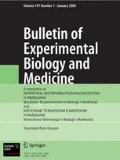We studied the distribution of ferrihydrite nanoparticles isolated from bacteria Klebsiella oxytoca in the whole body in vivo and in a cultured isolated organ (liver). The possibility of controlling these nanoparticles in the body using a magnetic field was assessed. One hour after intravenous injection of ferrihydrite nanoparticles to mice, their accumulation was observed in the liver, lungs, and kidneys. Experiment with cultured isolated rat liver showed that these nanoparticles can be controlled by a magnetic field and the influence of magnetic nanoparticles on the liver over 1 h does not lead to destruction of liver cells associated with the release of the marker enzyme AST. These results show the possibility of using magnetic nanoparticles as a system for controlled drug delivery in the body.
Similar content being viewed by others
References
Balaev DA, Dubrovskii AA, Krasikov AA, Stolyar SV, Iskhakov RS, Ladygina VP, Khilazhaeva ED. Mechanism of formation of uncompensated magnetic moment in ferrihydrite nanoparticles of bacterial origin. Pis’ma Zh. Eksp. Ter. Fiziki. 2013;98(3-4):160-164. Russian.
Dobretsov KG, Sipkin AV, Stolyar SV, Inzhevatkin EV, Ladygina VP, Ishchenko LV, Stolyar IA, Vinnik YuS, Lopatin AS. Targeted antibiotic delivery in the treatment of chronic rhinosinusitis. Ross. Rinol. 2010;18(3):24-25. Russian.
Dobretsov KG, Stolyar SV, Kolenchukova OA, Chizhova IA, Inzhevatkin EV. The method of the targeted delivery of an antibiotic into the nasal cavity for the treatment of wounds and inflammatory processes (an experimental study). Ross. Rinol. 2017;25(4):3-8. Russian.
Ladygina VP, Purtov KV, Stoljar SV, Iskhakov RS, Bajukov OA, Gurevich JL, Dobretsov KG, Ishchenko L.A. Patent RU No. 2457074. Method of producing ferrihydrite nanoparticles. Bull. No. 21. Published July 27, 2012.
Pakhomova VG, Shadrin KV, Rupenko AP, Krukova OV, Morgulis II. The response of the rat liver to normobaric hypoxia stimulated in vivo and in vitro. Biophysics. 2017;62(4):636-640.
Rupenko AP, Kruglik OV, Morgulis II. Oxygen supply of rat liver under the conditions of isolated perfusion. Dokl. Biol. Sci. 2008;418(1):4-6.
Rupenko AP1, Kruglik OV, Morgulis II. Functional activity of isolated perfused rat liver depends on medium composition. Bull. Exp. Biol. Med. 2008;146(1):107-110.
Stolyar SV, Bayukov OA, Denisova EA, Iskhakov RS, Bitekhtina MA, Gurevich YuL, Ladygina VP, Puzyr’ AP, Pustoshilov PP. Iron-containing nanoparticles from microbial metabolism. Inorganic Materials. 2006;42(7):763-768.
Stolyar SV, Bayukov OA, Ishkakov RS, Gurevich YuL, Ladygina VP. Mössbauer investigation of iron-producing bacteria Klebsiella oxytoca. Bull. Russ. Acad. Sci.: Physics. 2007;71(9):1286-1290.
Stolyar SV, Bayukov OA, Iskhakov RS, Gurevich YuL, Ladygina VP, Pustoshilov PP. Mössbauer study of bacterial ferrihydrite. Inorganic Materials. 2007;43(6):638-641.
Arosio P, Elia L, Poli M. Ferritin, cellular iron storage and regulation. IUBMB Life. 2017;69(6):414-422.
Balasoiu M, Kuklin AI, Soloviov DV, Arzumanian GM, Ischenko LA, Stolyar SV, Iskhakov RS, Raikher YL, Kurkin TS, Aranghel D. Structural investigation of biogenic ferrihydrite nanoparticles dispersion. Optoelectronics Adv. Mater. Rapid Communications. 2010;4(12):2136-2139.
Baldi F, Minacci A, Pepi M, Scozzafava A. Gel sequestration of heavy metals by Klebsiella oxytoca isolated from iron mat. FEMS Microbiol. Ecol. 2001.Vol. 36(2-3):169-174.
Koorts AM, Viljoen M. Ferritin and ferritin isoforms I: Structure- function relationships, synthesis, degradation and secretion. Arch. Physiol. Biochem. 2007;113(1):30-54.
Lovley DR, Phillips EJ. Novel mode of microbial energy metabolism: organic carbon oxidation coupled to dissimilatory reduction of iron or manganese. Appl. Environ. Microbiol. 1988;54(6):1472-1480.
Author information
Authors and Affiliations
Corresponding author
Additional information
Translated from Byulleten’ Eksperimental’noi Biologii i Meditsiny, Vol. 168, No. 12, pp. 753-756, December, 2019
Rights and permissions
About this article
Cite this article
Inzhevatkin, E.V., Osipova, E.D., Shadrin, K.V. et al. Distribution of Ferrihydrite Nanoparticles in the Body and Possibility of Controlling Them in an Isolated Organ by a Permanent Magnetic Field. Bull Exp Biol Med 168, 789–792 (2020). https://doi.org/10.1007/s10517-020-04803-y
Received:
Published:
Issue Date:
DOI: https://doi.org/10.1007/s10517-020-04803-y




